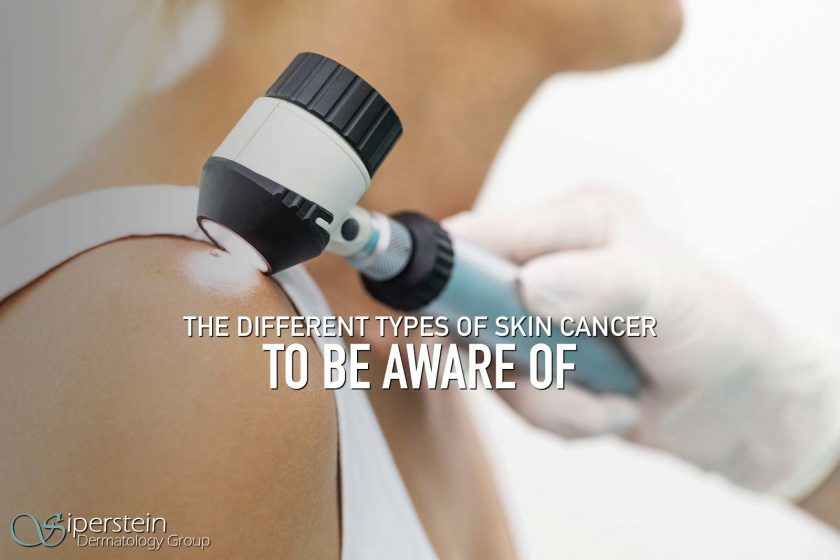Skin cancer is one of the few cancers which may be visibly detected in its early stages. Each year in the United States, more people are diagnosed with skin cancer than all other types of cancer combined. Skin cancer is especially common in Florida where most people are exposed to the sun all year round. Luckily, if caught early, most types of skin cancer are usually easily treated and have a good prognosis. For this reason, knowledge can make a huge difference to early detection and prevention: if you are aware of the different skin cancers and their signs and symptoms, you are more likely to notice cancerous growths in their early stages, which will improve your chances of being cured.
Types of Skin Cancers
Many people think that there is only one type of skin cancer. However, there are three main types of skin cancer. This is because there are multiple types of skin cells in which skin cancer can develop. The type of skin cancer a patient has will depend on the type of cells from which the cancer develops. The three main types of skin cancer are basal cell carcinoma, squamous cell carcinoma, and melanoma. Melanoma is the most serious of these, and it develops from the pigment producing cells in the skin. Basal cell carcinoma and squamous cell carcinoma, which are collectively referred to as “non-melanoma skin cancer,” develop from the other types of cells that make up the upper most layers of the skin (the epidermis).
Basal Cell Carcinoma
Basal cell carcinoma is an uncontrolled growth of atypical cells in in the basal layer, which is the deepest layer of the epidermis. It is the most common, and least dangerous, form of skin cancer. According to the American Cancer Society, it makes up 80% of reported cases of skin cancer. It typically develops on the head, neck or chest, as these are the most sun-exposed areas. It can look like a white, shiny lump or a dry, scaly, red patch. It may take months or even years to grow, and sometimes looks like an ulcer or sore in its developed stages. This type of skin cancer rarely spreads to other parts of the body. However, it may spread if left untreated, which is why early detection remains important. Patients who have had basal cell carcinoma should be particularly vigilant in their self-examination routines, as roughly 50% of patients who have had basal cell carcinoma are likely to develop new basal cell carcinoma within five years of their treatment.
Squamous Cell Carcinoma
Squamous cell carcinoma develops in the squamous cells, which are skin cells found in the epidermis (the skin’s outermost layer). This is the second most prevalent form of skin cancer. It can look like red, scaly patches, which may develop into open sores or non-healing ulcers. Since squamous cell carcinoma is a slow-growing cancer, it is not as immediately dangerous as melanoma. However, if left untreated it may grow in size and spread to other areas of the body, which makes it more difficult to remove. It rarely results in death. Actinic keratoses are pre-cancerous lesions, which look like a rough, scaly, patch in sun-exposed areas. Often, patients describe them as feeling sensitive, or like a small splinter or piece of glass under their skin when touched. A small percentage of cases of actinic keratosis will develop into squamous cell carcinoma. They can be treated with liquid nitrogen, blue light, or topical chemotherapy to prevent them from progressing to squamous cell carcinoma. Patients who have actinic keratosis should monitor their growth and report any changes to their dermatologist.
Melanoma
Melanoma is the most dangerous form of skin cancer. It may develop quickly and can become life-threatening., as it may easily spread to other parts of the body through the lymph nodes. Melanoma usually looks like an atypical, growing or changing mole, which is why regular self-examination is important. Melanoma may be flat or raised, usually has irregular borders, and often has multiple colors, such as black, brown, pink, or grey. Dermatologists recommend that patients use the ‘ABCD’ rule when checking themselves for melanoma. A is for ‘asymmetry’ – look to see if the spot is asymmetrical (harmless moles are usually round, with smooth borders and uniform color). B is for ‘border’ – if the spot has an uneven border, this could mean it is melanoma. C is for ‘color’ – spots which have uneven or unusual color should be checked by your dermatologist. D is for ‘diameter’ – generally, if the spot’s diameter is more than the size of a pencil eraser, this is a warning sign to take note of. Normal moles tend to have neat, defined edges, have a single color, and do not change over time. The most serious type of melanoma is nodular melanoma. Nodular melanoma is a, raised bump which is usually red or black in color. It must be treated as soon as possible as it is highly dangerous.
Early Detection Could Be Life-Saving
Skin cancer is one of the few cancers for which you can play an active role in both prevention and early detection. Conduct regular skin examinations in the mirror and take note of any new spots or any changes to existing moles so that they can be screened by a dermatologist. Be sure to have a family member or handheld mirror to help you check areas which are hard to see yourself, such as the back and scalp. If you’re aware of the different forms of skin cancer and know the symptoms to look out for, chances are you’ll be able to intervene early in any cancerous growths and improve your chances of simple and effective skin cancer treatment.
If you notice a new or changing mole or would like to have a preventative skin cancer screening, please call our office to schedule your thorough check with one of our highly qualified board certified dermatologists—561-364-7774.


